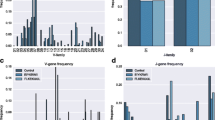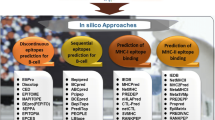Abstract
Identification of T-cell epitopes binding to MHC class II molecules is an important step in epitope-based vaccine development. This process has since been accelerated with the use of bioinformatics tools to aid in the prediction of peptide binding to MHC class II molecules and also to systematically scan for candidate peptides in antigenic proteins. There have been many prediction software developed over the years using various methods and algorithms and they are becoming increasingly sophisticated. Here, we illustrate the use of machine learning algorithms to train on MHC class II peptide data represented by feature vectors describing their amino acid physicochemical properties. The developed prediction model can then be used to predict new peptide data.
Access this chapter
Tax calculation will be finalised at checkout
Purchases are for personal use only
Similar content being viewed by others
References
Lafuente EM, Reche PA (2009) Prediction of MHC-peptide binding: a systematic and comprehensive overview. Curr Pharm Des 15(28):3209–3220
Tong JC, Tan TW, Ranganathan S (2007) Methods and protocols for prediction of immunogenic epitopes. Brief Bioinform 8(2):96–108
Wang P, Sidney J, Dow C et al (2008) A systematic assessment of MHC class II peptide binding predictions and evaluation of a consensus approach. PLoS Comput Biol 4(4):e1000048
Lata S, Bhasin M, Raghava GP (2009) MHCBN 4.0: a database of MHC/TAP binding peptides and T-cell epitopes. BMC Res Notes 2:61
Vita R, Zarebski L, Greenbaum JA et al (2010) The immune epitope database 2.0. Nucleic Acids Res 38(Database issue):D854–D862
Hall M, Frank E, Holmes G et al (2009) The WEKA data mining software: an update. ACM SIGKDD Explorations Newslett 11(1):10–18
Dubchak I, Muchnik I, Mayor C et al (1999) Recognition of a protein fold in the context of the Structural Classification of Proteins (SCOP) classification. Proteins 35(4):401–407
El-Manzalawy Y, Dobbs D, Honavar V (2008) On evaluating MHC-II binding peptide prediction methods. PLoS One 3(9):e3268
Li ZR, Lin HH, Han LY et al (2006) PROFEAT: a web server for computing structural and physicochemical features of proteins and peptides from amino acid sequence. Nucleic Acids Res 34(Web Server issue):W32–W37
Tomii K, Kanehisa M (1996) Analysis of amino acid indices and mutation matrices for sequence comparison and structure prediction of proteins. Protein Eng 9(1):27–36
Cui J, Han LY, Lin HH et al (2007) Prediction of MHC-binding peptides of flexible lengths from sequence-derived structural and physicochemical properties. Mol Immunol 44(5):866–877
Gowthaman U, Agrewala JN (2008) In silico tools for predicting peptides binding to HLA-class II molecules: more confusion than conclusion. J Proteome Res 7(1):154–163
Author information
Authors and Affiliations
Corresponding author
Editor information
Editors and Affiliations
Rights and permissions
Copyright information
© 2015 Springer Science+Business Media New York
About this protocol
Cite this protocol
Eng, L.P., Tan, T.W., Tong, J.C. (2015). Building MHC Class II Epitope Predictor Using Machine Learning Approaches. In: Zhou, P., Huang, J. (eds) Computational Peptidology. Methods in Molecular Biology, vol 1268. Humana Press, New York, NY. https://doi.org/10.1007/978-1-4939-2285-7_4
Download citation
DOI: https://doi.org/10.1007/978-1-4939-2285-7_4
Published:
Publisher Name: Humana Press, New York, NY
Print ISBN: 978-1-4939-2284-0
Online ISBN: 978-1-4939-2285-7
eBook Packages: Springer Protocols




